6.2: Asteroids and Meteoroids
\newcommand{\vecs}[1]{\overset { \scriptstyle \rightharpoonup} {\mathbf{#1}} }
\newcommand{\vecd}[1]{\overset{-\!-\!\rightharpoonup}{\vphantom{a}\smash {#1}}}
\newcommand{\id}{\mathrm{id}} \newcommand{\Span}{\mathrm{span}}
( \newcommand{\kernel}{\mathrm{null}\,}\) \newcommand{\range}{\mathrm{range}\,}
\newcommand{\RealPart}{\mathrm{Re}} \newcommand{\ImaginaryPart}{\mathrm{Im}}
\newcommand{\Argument}{\mathrm{Arg}} \newcommand{\norm}[1]{\| #1 \|}
\newcommand{\inner}[2]{\langle #1, #2 \rangle}
\newcommand{\Span}{\mathrm{span}}
\newcommand{\id}{\mathrm{id}}
\newcommand{\Span}{\mathrm{span}}
\newcommand{\kernel}{\mathrm{null}\,}
\newcommand{\range}{\mathrm{range}\,}
\newcommand{\RealPart}{\mathrm{Re}}
\newcommand{\ImaginaryPart}{\mathrm{Im}}
\newcommand{\Argument}{\mathrm{Arg}}
\newcommand{\norm}[1]{\| #1 \|}
\newcommand{\inner}[2]{\langle #1, #2 \rangle}
\newcommand{\Span}{\mathrm{span}} \newcommand{\AA}{\unicode[.8,0]{x212B}}
\newcommand{\vectorA}[1]{\vec{#1}} % arrow
\newcommand{\vectorAt}[1]{\vec{\text{#1}}} % arrow
\newcommand{\vectorB}[1]{\overset { \scriptstyle \rightharpoonup} {\mathbf{#1}} }
\newcommand{\vectorC}[1]{\textbf{#1}}
\newcommand{\vectorD}[1]{\overrightarrow{#1}}
\newcommand{\vectorDt}[1]{\overrightarrow{\text{#1}}}
\newcommand{\vectE}[1]{\overset{-\!-\!\rightharpoonup}{\vphantom{a}\smash{\mathbf {#1}}}}
\newcommand{\vecs}[1]{\overset { \scriptstyle \rightharpoonup} {\mathbf{#1}} }
\newcommand{\vecd}[1]{\overset{-\!-\!\rightharpoonup}{\vphantom{a}\smash {#1}}}
\newcommand{\avec}{\mathbf a} \newcommand{\bvec}{\mathbf b} \newcommand{\cvec}{\mathbf c} \newcommand{\dvec}{\mathbf d} \newcommand{\dtil}{\widetilde{\mathbf d}} \newcommand{\evec}{\mathbf e} \newcommand{\fvec}{\mathbf f} \newcommand{\nvec}{\mathbf n} \newcommand{\pvec}{\mathbf p} \newcommand{\qvec}{\mathbf q} \newcommand{\svec}{\mathbf s} \newcommand{\tvec}{\mathbf t} \newcommand{\uvec}{\mathbf u} \newcommand{\vvec}{\mathbf v} \newcommand{\wvec}{\mathbf w} \newcommand{\xvec}{\mathbf x} \newcommand{\yvec}{\mathbf y} \newcommand{\zvec}{\mathbf z} \newcommand{\rvec}{\mathbf r} \newcommand{\mvec}{\mathbf m} \newcommand{\zerovec}{\mathbf 0} \newcommand{\onevec}{\mathbf 1} \newcommand{\real}{\mathbb R} \newcommand{\twovec}[2]{\left[\begin{array}{r}#1 \\ #2 \end{array}\right]} \newcommand{\ctwovec}[2]{\left[\begin{array}{c}#1 \\ #2 \end{array}\right]} \newcommand{\threevec}[3]{\left[\begin{array}{r}#1 \\ #2 \\ #3 \end{array}\right]} \newcommand{\cthreevec}[3]{\left[\begin{array}{c}#1 \\ #2 \\ #3 \end{array}\right]} \newcommand{\fourvec}[4]{\left[\begin{array}{r}#1 \\ #2 \\ #3 \\ #4 \end{array}\right]} \newcommand{\cfourvec}[4]{\left[\begin{array}{c}#1 \\ #2 \\ #3 \\ #4 \end{array}\right]} \newcommand{\fivevec}[5]{\left[\begin{array}{r}#1 \\ #2 \\ #3 \\ #4 \\ #5 \\ \end{array}\right]} \newcommand{\cfivevec}[5]{\left[\begin{array}{c}#1 \\ #2 \\ #3 \\ #4 \\ #5 \\ \end{array}\right]} \newcommand{\mattwo}[4]{\left[\begin{array}{rr}#1 \amp #2 \\ #3 \amp #4 \\ \end{array}\right]} \newcommand{\laspan}[1]{\text{Span}\{#1\}} \newcommand{\bcal}{\cal B} \newcommand{\ccal}{\cal C} \newcommand{\scal}{\cal S} \newcommand{\wcal}{\cal W} \newcommand{\ecal}{\cal E} \newcommand{\coords}[2]{\left\{#1\right\}_{#2}} \newcommand{\gray}[1]{\color{gray}{#1}} \newcommand{\lgray}[1]{\color{lightgray}{#1}} \newcommand{\rank}{\operatorname{rank}} \newcommand{\row}{\text{Row}} \newcommand{\col}{\text{Col}} \renewcommand{\row}{\text{Row}} \newcommand{\nul}{\text{Nul}} \newcommand{\var}{\text{Var}} \newcommand{\corr}{\text{corr}} \newcommand{\len}[1]{\left|#1\right|} \newcommand{\bbar}{\overline{\bvec}} \newcommand{\bhat}{\widehat{\bvec}} \newcommand{\bperp}{\bvec^\perp} \newcommand{\xhat}{\widehat{\xvec}} \newcommand{\vhat}{\widehat{\vvec}} \newcommand{\uhat}{\widehat{\uvec}} \newcommand{\what}{\widehat{\wvec}} \newcommand{\Sighat}{\widehat{\Sigma}} \newcommand{\lt}{<} \newcommand{\gt}{>} \newcommand{\amp}{&} \definecolor{fillinmathshade}{gray}{0.9}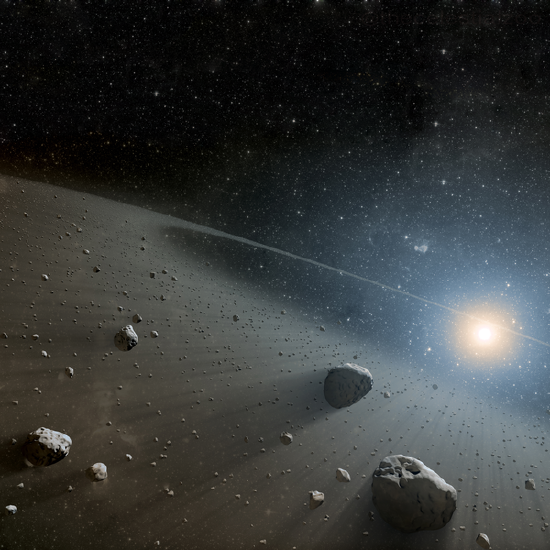 The Asteroid Belt.
The Asteroid Belt.
6.2.1 Asteroids
The average distance between planetary orbits gets bigger as we move out into the solar system. The distance between Mercury and Venus is less than the distance between Venus and Earth, which is less than the distance between Earth and Mars, and so on. However, astronomers noticed a gap in between the orbits of Mars and Jupiter that did not fit the pattern. Many were sure a planet must occupy this region. In 1801, Italian astronomer Giuseppe Piazzi discovered Ceres. Too small to be a planet, Ceres nonetheless fit the location where astronomers expected to find one. Eventually, astronomers found more and more small, rocky bodies, which they named asteroids, in what is now called the Asteroid Belt.
.jpg?revision=1&size=bestfit&width=550&height=550) Ceres. Note the white patch on the right that could be exposed ice.
Ceres. Note the white patch on the right that could be exposed ice.
https:/commons.wikimedia.org/wiki/File:Ceres_-_RC3_-_Haulani_Crater_(22381131691).jpg;
The origin of the asteroid belt puzzled astronomers. Where they the remnants of a planet that had explode or was torn apart by Jupiter’s massive gravity? It turns out, no. If you took all the asteroids and put them together into a single body, they would be smaller than our Moon. There just is not enough mass in the Asteroid belt to make up a planet. Instead, astronomers have concluded that, in the early days of the solar system, as the planets were forming, there was a race to gather as much as mass as possible. Jupiter got a head start and gobbled up much of the mass in that vicinity. Asteroids, then, are simply leftover debris that lacked enough mass to gather together into a single body.
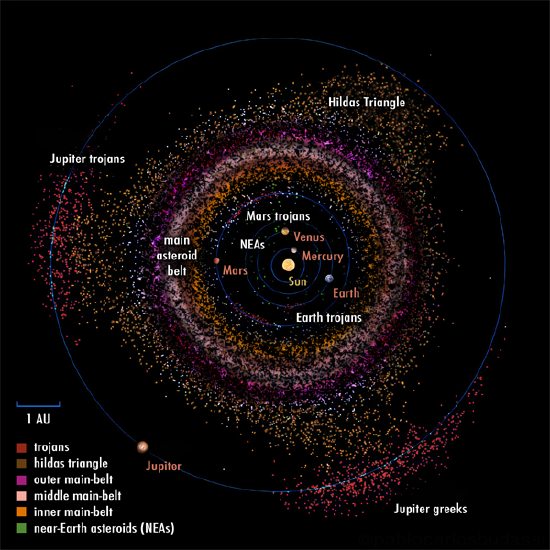 The Asteroid Belt.
The Asteroid Belt.
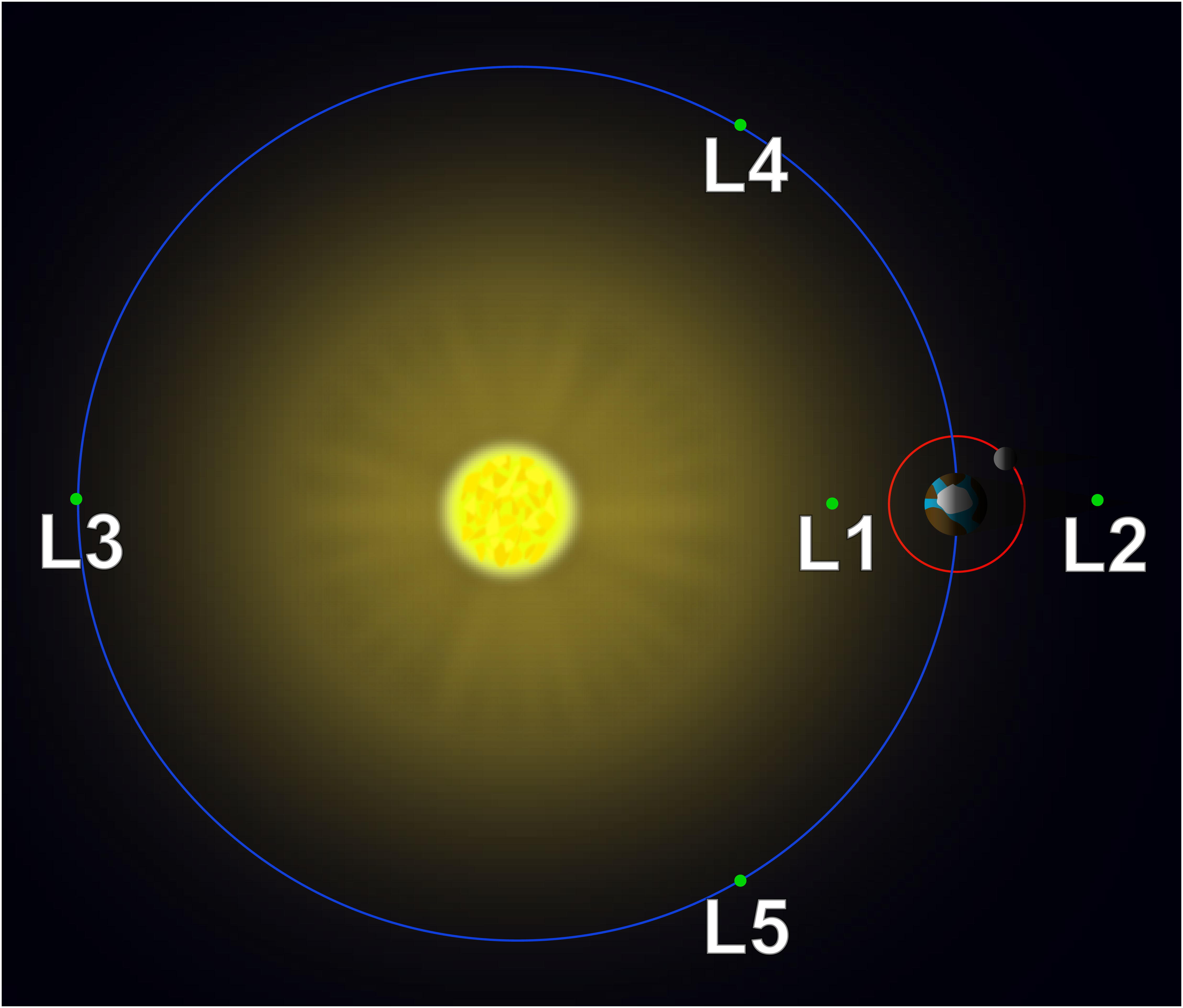 The Lagrange Points are islands of stability between the Sun and a planet where the gravitational forces are in balance.
The Lagrange Points are islands of stability between the Sun and a planet where the gravitational forces are in balance.
You may have seen science fiction movies flying through an asteroid field, dodging rocks, right and left. This makes for exciting drama, but it is not an accurate reflection of the Asteroid Belt. If asteroids really orbited as close together as depicted in the movies, they would either collide and knock each other further apart or be pulled together into a single body. In reality, you could fly through the Asteroid Belt and never even see a single asteroid as the average distance between them is millions of kilometers.
Asteroids are classified by their composition as follows:
1. The C-type (chondrite) asteroids are most common, probably consist of clay and silicate rocks, and are dark in appearance. They are among the most ancient objects in the solar system.
2. The S-types ("stony") are made up of silicate materials and nickel-iron.
3. The M-types are metallic (nickel-iron). These were probably formed by impacts that heated the rocks and separated the metals into a core.
Many asteroids are known to contain ice and some, like Ceres, are large enough to self-gravitate into a sphere like planets. Many have also differentiated into a metallic core and a rocky crust, indicated that during formation, they had heated up to become molten. Others are fragments of larger bodies, that broke apart during collisions, such as metallic asteroids being former cores of much larger bodies. Some asteroids are solid while others little more than piles of rubble held together by their mutual gravity. Some asteroids even have moons, small asteroids bond to their gravitational pull.
Astronomers also discovered asteroids sharing Jupiter’s orbit, both ahead and trailing behind the gas giant. These asteroids occupy the L4 and L5 Lagrange points. In any system in which a planet orbits a star (or a moon orbits a planet), there are certain points where the gravity of the two bodies balance out. Lagrange points form zones of stability. Place an object in a Lagrange point and it will orbit in such a way that it will maintain the same relative position with respect to the planet and the star. The L4 Lagrange point is in the planet’s orbital path 60˚ ahead of planet and the L5 Lagrange point is located 60˚ behind the planet. The German astronomer Max Wolf discovered the first asteroid in Jupiter’s L5 point and named it Achilles, after the hero of the Trojan War in Homer’s Iliad. As a result, astronomers called these asteroids Trojan Asteroids. By convention, astronomers named asteroids in the L5 point after the Greek fighters and the asteroids in the L4 point after Trojan warriors. Often, astronomers refer to these asteroids as the Greek and Trojan camps, respectively.
Since the discovery of Jupiter’s Trojan asteroids, astronomers have found similar asteroids in orbit in the L4 and L5 points of other planetary orbits, including the Sun-Mars Lagrange points and the Sun-Earth Lagrange points.
Other asteroids have more irregular orbits that take them into the inner solar system. Some cross Earth’s orbit and astronomers refer to them as Earth-crossing or Apollo asteroids. One such asteroid hit the Earth 65 million years ago, ending the era of the dinosaurs. Because a similar collision today would cause a civilization-ending catastrophe, astronomers have begun searching for and tracking Apollo asteroids to determine if any have the potential of hitting the Earth any time in the near future.
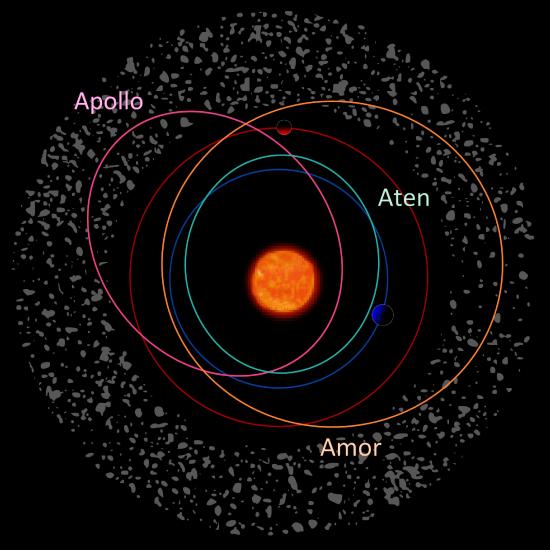 Apollo and other Earth crossing asteroids.
Apollo and other Earth crossing asteroids.
If we do find an asteroid heading our way, what could we do? Again, Hollywood gives us the impression that perhaps blowing up the asteroid might work. Even an exploded asteroid could be devastating as all the debris would still be heading toward Earth. Indeed, it might make matters worse as the devastation would be spread out over a wider area. Instead, some scientists have suggested giving the asteroid a push to divert it away from the Earth. This could be done by hitting it with a projectile that would not blow up the asteroid, just give it a little nudge. Alternatively, laser could be used to ablate (vaporize) a side of the asteroid, using the escaping gasses to push the asteroid away, just like escaping gases use Newton’s laws to propel a rocket (Section 3.5).
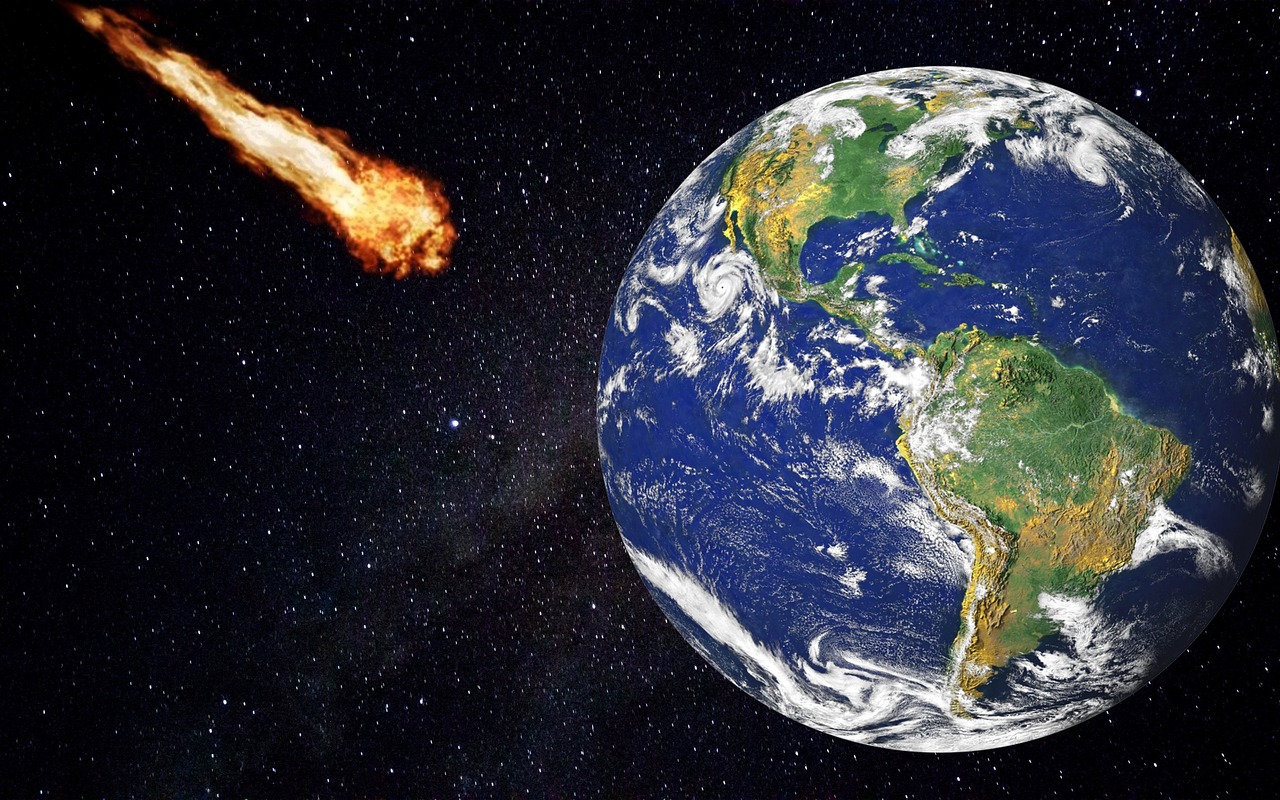 Asteroid approaching Earth.
Asteroid approaching Earth.
https:/www.needpix.com/photo/1682066/asteroid-comet;
6.2.2 Meteoroids
Astronomers often call smaller rocky bodies meteoroids, although there is no hard rule on the difference between a small asteroid and a large meteoroid. If a meteoroid enters our atmosphere, it heats up, producing a streak of light we call a shooting star or a meteor. Any part of a meteor that does not burn up and impacts the ground is called a meteorite. Since meteorites are leftover rocky debris from the earliest days of our solar system’s history, scientists often study them for clues about the origin of the solar system. Like asteroids, we classify meteorites by the composition:
1. Irons: “pure” iron-nickel
2. Stones: silicate or rocky material
3. Stoney-irons: mixture of metallic iron and rocky material
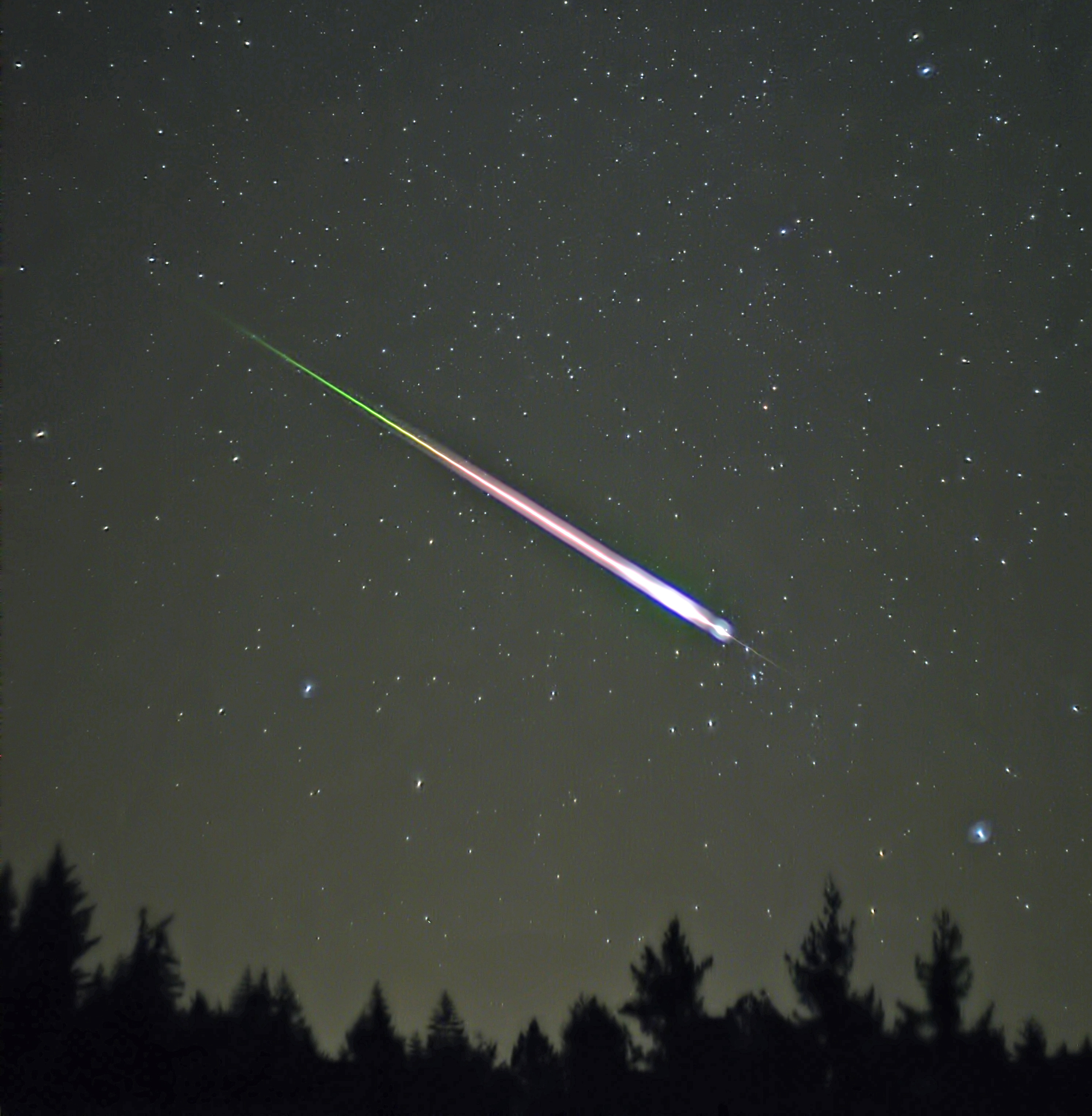 A meteor.
A meteor.
https:/commons.wikimedia.org/wiki/File:Leonid_Meteor.jpg;
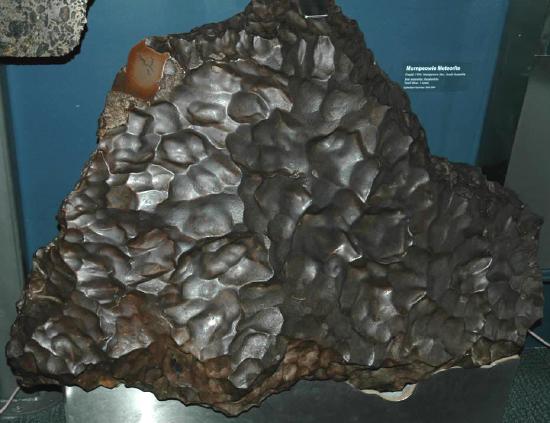 A meteorite.
A meteorite.
https:/commons.wikimedia.org/wiki/File:Murnpeowie_meteorite.jpg;
In contrast, a meteor shower occurs when numerous meteors fall through the sky at once. These come from comets have broken apart. As the Earth orbits the Sun, it passes through some of the debris fields leftover from the cometary remains, producing annual meteor showers. We name meteor showers after the constellation the meteors appear to radiate from. For example, the Leonid meteor shower appears in the constellation Leo and occurs in November while the Perseids (in the constellation Perseus) occur in late July-early August.
 Gemind Meteor Shower.
Gemind Meteor Shower.
https:/www.flickr.com/photos/slworking/38218967245;






